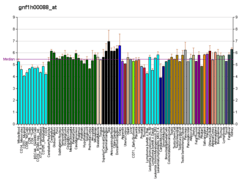RP1
Oxygen-regulated protein 1 also known as retinitis pigmentosa 1 protein (RP1) is a protein that in humans is encoded by the RP1 gene.[5][6]
Function
Initially named for its response to in vivo retinal oxygen levels (designated ORP1 for 'oxygen-regulated protein-1'), this gene was subsequently linked to autosomal dominant retinitis pigmentosa and was renamed RP1 for 'retinitis pigmentosa 1'. The data suggest that mutations in this gene cause dominant RP, and that the encoded protein has an important but unknown role in photoreceptor biology.[6]
References
- 1 2 3 GRCh38: Ensembl release 89: ENSG00000104237 - Ensembl, May 2017
- 1 2 3 GRCm38: Ensembl release 89: ENSMUSG00000025900 - Ensembl, May 2017
- ↑ "Human PubMed Reference:".
- ↑ "Mouse PubMed Reference:".
- ↑ Blanton SH, Heckenlively JR, Cottingham AW, Friedman J, Sadler LA, Wagner M, Friedman LH, Daiger SP (Mar 1992). "Linkage mapping of autosomal dominant retinitis pigmentosa (RP1) to the pericentric region of human chromosome 8". Genomics. 11 (4): 857–69. doi:10.1016/0888-7543(91)90008-3. PMID 1783394.
- 1 2 "Entrez Gene: RP1 retinitis pigmentosa 1 (autosomal dominant)".
Further reading
- Juwana JP, Henderikx P, Mischo A, et al. (1999). "EB/RP gene family encodes tubulin binding proteins". Int. J. Cancer. 81 (2): 275–84. doi:10.1002/(SICI)1097-0215(19990412)81:2<275::AID-IJC18>3.0.CO;2-Z. PMID 10188731.
- Pierce EA, Quinn T, Meehan T, et al. (1999). "Mutations in a gene encoding a new oxygen-regulated photoreceptor protein cause dominant retinitis pigmentosa". Nat. Genet. 22 (3): 248–54. doi:10.1038/10305. PMID 10391211.
- Sullivan LS, Heckenlively JR, Bowne SJ, et al. (1999). "Mutations in a novel retina-specific gene cause autosomal dominant retinitis pigmentosa". Nat. Genet. 22 (3): 255–9. doi:10.1038/10314. PMC 2582380. PMID 10391212.
- Guillonneau X, Piriev NI, Danciger M, et al. (1999). "A nonsense mutation in a novel gene is associated with retinitis pigmentosa in a family linked to the RP1 locus". Hum. Mol. Genet. 8 (8): 1541–6. doi:10.1093/hmg/8.8.1541. PMID 10401003.
- Liu Q, Zhou J, Daiger SP, et al. (2002). "Identification and subcellular localization of the RP1 protein in human and mouse photoreceptors". Invest. Ophthalmol. Vis. Sci. 43 (1): 22–32. PMC 1963488. PMID 11773008.
- Andersen JS, Lyon CE, Fox AH, et al. (2002). "Directed proteomic analysis of the human nucleolus". Curr. Biol. 12 (1): 1–11. doi:10.1016/S0960-9822(01)00650-9. PMID 11790298.
- Fujita Y, Ezura Y, Emi M, et al. (2004). "Hypertriglyceridemia associated with amino acid variation Asn985Tyr of the RP1 gene". J. Hum. Genet. 48 (6): 305–8. doi:10.1007/s10038-003-0029-z. PMID 12764676.
- Schwartz SB, Aleman TS, Cideciyan AV, et al. (2003). "De novo mutation in the RP1 gene (Arg677ter) associated with retinitis pigmentosa". Invest. Ophthalmol. Vis. Sci. 44 (8): 3593–7. doi:10.1167/iovs.03-0155. PMID 12882812.
- Ota T, Suzuki Y, Nishikawa T, et al. (2004). "Complete sequencing and characterization of 21,243 full-length human cDNAs". Nat. Genet. 36 (1): 40–5. doi:10.1038/ng1285. PMID 14702039.
- Kawamura M, Wada Y, Noda Y, et al. (2004). "Novel 2336-2337delCT mutation in RP1 gene in a Japanese family with autosomal dominant retinitis pigmentosa". Am. J. Ophthalmol. 137 (6): 1137–9. doi:10.1016/j.ajo.2003.12.037. PMID 15183808.
- Khaliq S, Abid A, Ismail M, et al. (2006). "Novel association of RP1 gene mutations with autosomal recessive retinitis pigmentosa". J. Med. Genet. 42 (5): 436–8. doi:10.1136/jmg.2004.024281. PMC 1736063. PMID 15863674.
- Riazuddin SA, Zulfiqar F, Zhang Q, et al. (2005). "Autosomal recessive retinitis pigmentosa is associated with mutations in RP1 in three consanguineous Pakistani families". Invest. Ophthalmol. Vis. Sci. 46 (7): 2264–70. doi:10.1167/iovs.04-1280. PMID 15980210.
- Roberts L, Bartmann L, Ramesar R, Greenberg J (2006). "Novel variants in the hotspot region of RP1 in South African patients with retinitis pigmentosa". Mol. Vis. 12: 177–83. PMID 16568030.
- Roni V, Carpio R, Wissinger B (2007). "Mapping of transcription start sites of human retina expressed genes". BMC Genomics. 8: 42. doi:10.1186/1471-2164-8-42. PMC 1802077. PMID 17286855.
External links
This article is issued from
Wikipedia.
The text is licensed under Creative Commons - Attribution - Sharealike.
Additional terms may apply for the media files.




